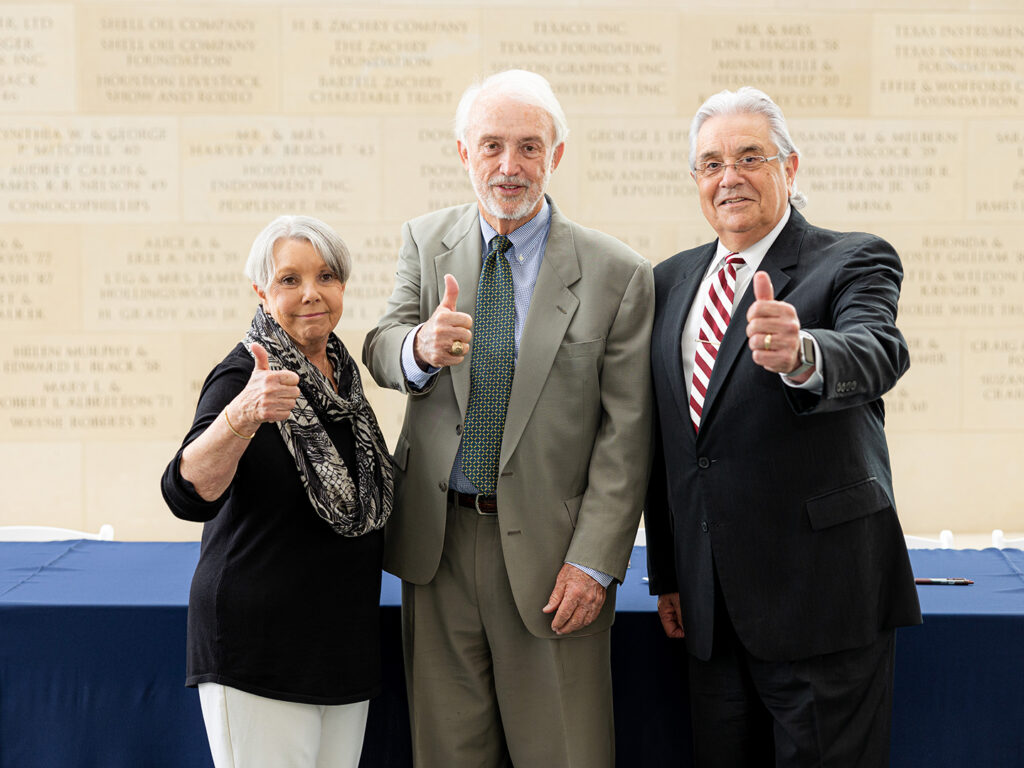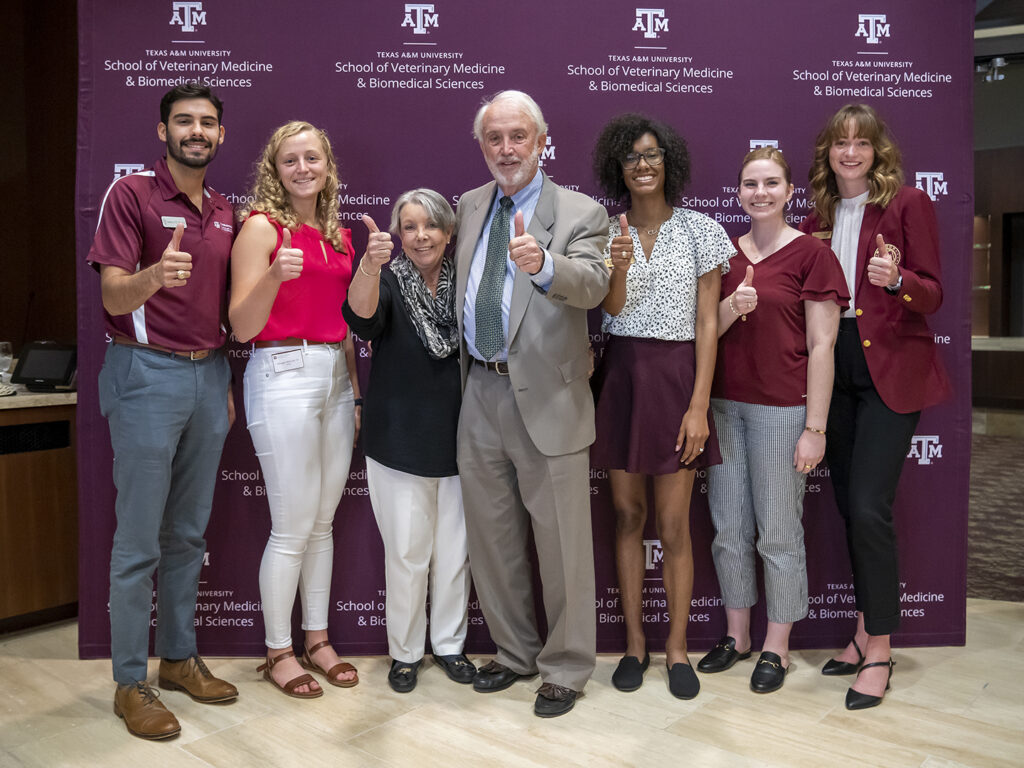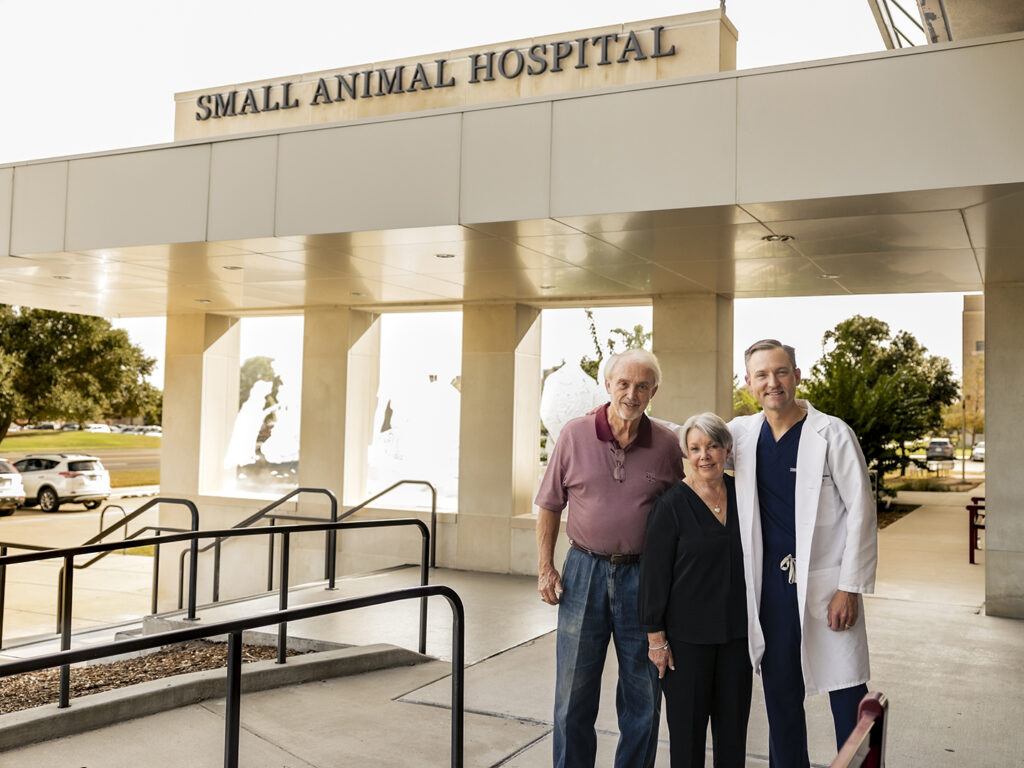Aggie Animal Lovers Donate Lead Gift For Texas A&M’s New Small Animal Teaching, Research Hospital
Story by Rachel Knight, VMBS Communications

Photos by Jason Nitsch ’14, Texas A&M School of Veterinary Medicine & Biomedical Sciences
Linda and Dennis Clark were driving through Scottsdale, Arizona, when an idea the couple had been considering for about a decade came up in the form of a question.
“So, how do you feel about giving away $20 million?” Dennis asked his wife.
“Linda and I had been considering this gift for some time and we both knew that given the importance of the new small animal hospital project, we needed to make a decision,” Dennis explained as they recalled the story. “We both loved the idea of supporting the new hospital project and had talked about it at great length. It was just one of those moments where I thought we need to make a commitment — no more talking.”
After an initial moment of shock, Linda agreed that the new Small Animal Teaching & Research Hospital (SATRH) at the Texas A&M School of Veterinary Medicine & Biomedical Sciences (VMBS) was a sound investment in the future of the school, the university, and all of the small animals that would benefit from having such a fantastic facility in which to receive veterinary care.
With the decision made, the Clarks began working with the Texas A&M Foundation to make the lead donation for the new facility. The couple officially signed the $20 million gift agreement in March 2023.
“It is a lot of money, but in the end, it was an easy decision,” Dennis said. “The idea of being part of the development of a world-class small animal teaching and research hospital that matched the outstanding research, education, and care already provided at Texas A&M made a lot of sense and was something we really wanted to help with.”
“I hope our gift will encourage other Aggies and non-Aggies to step up and bring this new hospital to fruition,” Linda said.
The Value Of Investing In Aggie Values
The Clarks are life-long animal lovers, avid Texas A&M supporters, and hard-working business owners who apply the Aggie core values in every part of their lives.
They both grew up in West Texas and both small and large animals were always part of their lives.
“Dogs were a huge part of my life growing up. My family always had a lot of big dogs, and they were always an important part of the family,” Dennis said. “After we were married, it only took Linda a short period of time to get used to having lots of dogs living in the house with us — she recognized they were family.”
Linda grew up more of a cat and horse person, but she quickly learned to share Dennis’s love of dogs and she made him a cat and horse lover.
“We just love all animals, but our dogs are a really special part of our lives,” Linda said.
Dennis began his studies at Texas A&M and graduated with a bachelor’s degree in political science in 1968. He also completed his master’s degree in business in 1971. While at Texas A&M, he was commissioned in the Army and reported to active duty after completing his second degree.

After the Army, Dennis began a career in the restaurant industry. Coincidentally, Linda had also chosen a career in the restaurant industry, and this convergence led to Linda and Dennis meeting at a Long John Silver’s convention in 1976. At the time, Dennis was working as an operation executive, and Linda was working in the company’s training program.
“We got married in ‘78,” Linda said. “In 1986, we decided to make a commitment to become franchisees of the Sonic restaurant concept and began developing Sonic Drive-ins in the Dallas-Fort Worth area. Over the years, we worked hard at building both our Sonic business and our development business. That work has paid off and we have enjoyed great success as a result.”
The Clarks eventually found themselves running 39 Sonic locations and a successful commercial real estate development business. Their dedication to Sonic resulted in numerous awards, including being named Sonic National Operator of the Year three times and both Linda and Dennis being inducted into the Sonic Hall of Fame in 2013.
Dennis attributes their success to their desire to be the best that they possibly can be in everything they do. He sees the same work ethic and desire in the Aggie veterinarians they’ve worked with over the years.
“For me, the words ‘Aggie’ and ‘ideal’ are just about synonymous. Aggie veterinarians are an example of both. Aggie vets come out of school with a degree of empathy that is different from a lot of other universities,” he said. “The standard of care they offer is better because they are more involved, more concerned, and more committed to getting the best possible outcome for their patients. I think all vets want the outcome to be good, but Aggie veterinarians are willing to go the extra mile to make sure that the most appropriate outcome occurs.”
The Clarks said it was easy to see what set Aggie veterinarians apart from their peers, but it was also clear that the current Small Animal Teaching Hospital (SATH) facility was presenting more hurdles than help for the veterinarians working in its halls.
“When you look at what we have at Texas A&M University in terms of the potential of the veterinary school, it is enormous, but right now, it is being limited by the facilities that are currently available at the small animal hospital. If we really want the world-class small animal and research program that we imagine, then we need a world-class facility. With that thought in mind, it seemed like the idea of helping develop a world-class small animal teaching and research hospital really made a lot of sense,” Dennis shared.
“We’ve been very blessed in our lives. We’ve worked very hard together and we have had a lot of good things happen. We’ve built several significant businesses, and we were financially in a position where we had the ability to do something like this from a philanthropic perspective,” he continued. “We would encourage everybody out there to take a look at the potential benefits of the new hospital and consider how they can contribute.”
Experiencing Compassionate Care

The Clarks’ love of animals is clear when you look at their family composition, which includes 44 horses, four dogs, and two cats.
“When you have a strong relationship with animals and you think of them in terms of being a family member, you want to make sure that you’re doing everything you possibly can for them,” Dennis said. “We do that in terms of local veterinary care and, when necessary, care here at Texas A&M. The reason we bring our animals to the SATH is simply because we want the absolute best possible outcome for them.”
The Clarks witnessed the compassionate care provided at the SATH for the first time when their Labrador retriever Molly needed a knee replacement. They experienced it again when one of their other Labradors, Cadbury, needed a knee replacement a few years later.
“Every time we had one of them up here, a fourth-year Doctor of Veterinary Medicine (DVM) student was assigned to their care in orthopedics,” Linda shared. “We were super impressed with the care and the consideration that those fourth-year students gave.”
It was clear from the daily, and sometimes twice daily, phone calls the Clarks received that the students helping provide Molly’s and Cadbury’s care quickly developed a deep compassion for their patients.
“When Cadbury was at the SATH, he had to stay for several days,” Linda said. “One of the fourth-year students who cared for him took him outside every day and let him lay in the sun while she had lunch, which we know he loved. Another student who worked with Cadbury on a different visit to the SATH made a special effort to tell Cadbury goodbye when Cadbury was being discharged, even though he’d been assigned to a different rotation in the hospital by the time Cadbury was ready to return home.”
The compassion that the Clarks witnessed while Molly and Cadbury were receiving care at the SATH reassured them that their family members were in good hands and heightened their interest in learning more about the work happening at the hospital.
Discovering Innovative Research
Molly’s and Cadbury’s knee replacements allowed the Clarks to see professor of orthopedic surgery Dr. Brian Saunders ‘98, ‘01, ‘05 in action.
Saunders not only performed successful knee replacement surgeries for both Molly and Cadbury but also introduced the Clarks to his groundbreaking orthopedics research that is funded with help from one of the two faculty chairs the Clarks endowed through the VMBS prior to meeting Saunders.
“Dr. Saunders’ work is fascinating to me,” Dennis said. “He’s working with the biomedical engineering department to develop a scaffolding in which proteins produced by stem cells are used to activate bone healing. In the future, it may be possible to take a bone sample from a patient, grow new bone from that sample, and use that bone to replace the missing bone in his patients. He’s developing protocols so that he can actually create a bridge that would create a natural bone that’s virtually identical to the bone that was damaged. It’s pretty amazing, really.”

The Clarks have also had the opportunity to learn about Dr. Jonathan Levine’s translational research that’s addressing issues in both veterinary and human medicine. Levine holds the Helen McWhorter Chair and serves as the Small Animal Clinical Sciences Department head.
“Dr. Levine’s work is also incredible. He has worked with pet dogs that have naturally occurring spinal cord injuries, using treatments that reduce inflammation and tissue breakdown after injury,” Dennis said. “The hope is to advance some of these therapies to humans with similar injury. How can you look at that and not be fascinated?”
Linda said she anticipates that others may not realize that building a new SATRH has an important role to play in curing some of the most challenging diseases and medical diagnoses affecting animals and humans alike.
“There will be people who ask, ‘Why would you give this much money to a veterinary school? You could have given that to cancer research or leukemia research,’” she said.
“What I would say to that is, read about these veterinarians. Pull up the stats. Pull up the webpage of the veterinarians who run the different departments. Learn about Dr. Jon Levine, read about Dr. Brian Saunders, and while you’re there, learn about the large animal vets like Dr. Jeff Watkins, too. Their work is contributing to advancements in medical care for both people and animals,” she continued. “That should tell you why we made the commitment to put this much money into the Texas A&M School of Veterinary Medicine & Biomedical Sciences.”
Touring the hospital and learning more about the research taking place at the SATH made it clear to the Clarks that the SATH facility was not up to par with the work taking place within its walls.
“The current facility is overtaxed, based on the patient load they have,” Dennis said. “In the course of our visits to the current small animal hospital, the problems were obvious. During those visits, the concept of building a new veterinary small animal teaching and research hospital came up and we were intrigued. We saw a new building benefiting both small animal care and the amazing research component that is going on as a very important need, and we really felt that we wanted to be a part of its development.”
Facilitating Exceptional Education
Texas A&M DVM students don’t just learn about some of the brightest veterinarians in the world like Saunders, Levine, and Watkins; the students also learn from them.
“Together, we have the opportunity to develop a world-class, cutting-edge medical teaching and research hospital with the potential to benefit the entire human race. Why wouldn’t you want to be a part of that?”
Dennis Clark ‘68, ‘71
“The opportunity for the students to work with all of the fine medical personnel here is a big plus,” Dennis explained. “The facilities that we have now constrain and limit the amount of interface that can be done with the students as well as the amount of work students can do while learning.”
While touring the facilities, the Clarks have seen the importance of improving the SATH’s ability to facilitate veterinary education.
“In order to properly educate to the best extent possible, all of the new veterinarians coming through this school need a new facility that has the ability to accommodate both them and the procedures and research that simultaneously shapes them into outstanding veterinarians,” Dennis shared.
Linda said she’s excited to see how the new facility enhances the Texas A&M core values in future Aggie veterinarians.
“Everywhere we go, we run into Aggies,” Linda said. “If you’re talking to some of the younger graduates, they’re excited to tell you about the Aggie values they developed in their time here. One Aggie alumnus told me that they don’t just talk about the Aggie core values at the vet school – they teach them and embed them in you. That’s what makes these students good community leaders and veterinary care providers after they graduate.”
Thanks to the Clarks’ leadership and generosity, Texas A&M is $20 million closer to making the SATRH a reality for future DVM students. Helping the VMBS continue its 107-year tradition of educational excellence contributed to the Clarks’ decision to make the lead gift.
Building A Healthier Future
The SATRH fundraising campaign kicked off with a strong start thanks to the Clarks. They encourage others to join them in building a healthier future.
“This hospital is going to work toward the betterment of all companion animals, not just those who make the trip to College Station, because the Aggies who graduate from the program will serve our communities after they graduate,” Dennis said. “The research that the new facility will better facilitate stands to improve both animal and human health. Together, we have the opportunity to develop a world-class, cutting-edge medical teaching and research hospital with the potential to benefit the entire human race. Why wouldn’t you want to be a part of that?”
Partner With Us
We invite you to partner with us on this exciting initiative. Outside donations will amplify resources pledged by the state and university, pushing the envelope of this project, and ensuring that it becomes a hub of research, academic, and compassionate care excellence.
Naming opportunities starting at $25,000 abound in the new facility, and spaces can be named in memory or honor of a special person or pet.
If you’d like to be part of advancing veterinary medicine with the Next Generation Small Animal Teaching & Research Hospital at Texas A&M, contact:
The VMBS Office of Development
979.845.9043
development-vmbs@tamu.edu
You can also support construction of the Next-Generation Small Animal Teaching & Research Hospital with gifts of $25 or more online at tx.ag/NextGenVetHospital.
###
Note: This story originally appeared in the Fall 2023 issue of VMBS Today.
For more information about the Texas A&M College of Veterinary Medicine & Biomedical Sciences, please visit our website at vetmed.tamu.edu or join us on Facebook, Instagram, and Twitter.
Contact Information: Jennifer Gauntt, Director of VMBS Communications, Texas A&M College of Veterinary Medicine & Biomedical Sciences; jgauntt@cvm.tamu.edu; 979-862-4216


